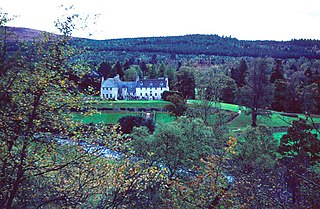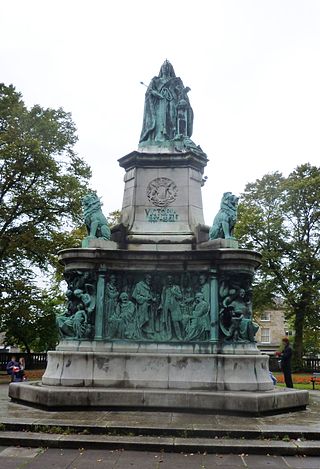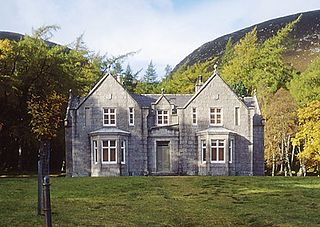Related Research Articles

Balmoral Castle is a large estate house in Aberdeenshire, Scotland, and a residence of the British royal family. It is near the village of Crathie, 9 miles (14 km) west of Ballater and 50 miles (80 km) west of Aberdeen.

John Brown was a Scottish personal attendant and favourite of Queen Victoria for many years after working as a gillie for Prince Albert. He was appreciated by many for his competence and companionship, and resented by others for his influence and informal manner. The exact nature of his relationship with Victoria was the subject of great speculation by contemporaries.

The Albert Memorial, directly north of the Royal Albert Hall in Kensington Gardens, London, was commissioned by Queen Victoria in memory of her beloved husband Prince Albert, who died in 1861. Designed by Sir George Gilbert Scott in the Gothic Revival style, it takes the form of an ornate canopy or pavilion 176 feet (54 m) tall, in the style of a Gothic ciborium over the high altar of a church, sheltering a statue of the prince facing south. It took over ten years to complete, the £120,000 cost met by public subscription.

Prince Leopold, Duke of Albany, was the eighth child and youngest son of Queen Victoria and Prince Albert. Leopold was later created Duke of Albany, Earl of Clarence, and Baron Arklow. He had haemophilia, which contributed to his death following a fall at the age of 30.

Princess Louise, Duchess of Argyll, was the sixth child and fourth daughter of Queen Victoria and Prince Albert.

Frogmore is an estate within the Home Park, adjoining Windsor Castle, in Berkshire, England. It comprises 33 acres (130,000 m2), of primarily private gardens managed by the Crown Estate. It is the location of Frogmore House, a royal retreat, and Frogmore Cottage. The name derives from the preponderance of frogs which have always lived in this low-lying and marshy area near the River Thames. This area is part of the local flood plain. Its large landscaped gardens are Grade I listed on the Register of Historic Parks and Gardens.

Sir Joseph Edgar Boehm, 1st Baronet, was an Austrian-born British medallist and sculptor, best known for the "Jubilee head" of Queen Victoria on coinage, and the statue of the Duke of Wellington at Hyde Park Corner. During his career Boehm maintained a large studio in London and produced a significant volume of public works and private commissions. A speciality of Boehm's was the portrait bust; there are many examples of these in the National Portrait Gallery. He was often commissioned by the Royal Family and members of the aristocracy to make sculptures for their parks and gardens. His works were many, and he exhibited 123 of them at the Royal Academy from 1862 to his death in 1890.

Sir John Robert Steell was a Scottish sculptor. He modelled many of the leading figures of Scottish history and culture, and is best known for a number of sculptures displayed in Edinburgh, including the statue of Sir Walter Scott at the base of the Scott Monument.

Gillie or ghillie is an ancient Gaelic term for a person who acts as a servant or attendant on a fishing, hunting, deer stalking or hawking expedition, primarily in the Scottish Highlands or on a river such as the River Spey. In origin it referred especially to someone who attended on his male employer or guests.

Birkhall is a 210 km2 estate on Royal Deeside, Aberdeenshire, Scotland, owned by King Charles III. It is located alongside the River Muick to the south-west of Ballater.

The statue of Queen Victoria by Joseph Edgar Boehm stands on College Green, Bristol, England. It is Grade II listed.

William Theed, also known as William Theed the younger, was a British sculptor, the son of the sculptor and painter William Theed the elder (1764–1817). Although versatile and eclectic in his works, he specialised in portraiture, and his services were extensively used by the Royal Family.

Abergeldie Castle is a four-floor tower house in Crathie and Braemar parish, SW Aberdeenshire, Scotland. It stands at an altitude of 840 feet (260 m), on the south bank of the River Dee, five miles (8 km) west of Ballater, and about two miles (3 km) east of the royal residence of Balmoral Castle. Behind it rises Creag nam Ban, a rounded granite hill about 527 metres (1,729 ft) high, and across the river to its front is the cairn-crowned Geallaig Hill, rising to 743 metres (2,438 ft).
Events from the year 1867 in Scotland.

John Hutchison was a Scottish sculptor based in Edinburgh. He was the son of an unnamed builder, and his artistic life began as a thirteen-year-old woodcarving apprentice. He attended art school in the evenings, then later became a student at the Trustees Academy. and attracted the patronage of its owner, Patrick Allan Fraser, who gave him commissions to fund his study in Rome. Although after Rome he continued to enjoy ancient Roman sculptural themes, he remained in Edinburgh for the rest of his life, working in wood, clay and marble, and concentrating on portraiture of Scottish people, and images of Scottish myth and history. He created the bust of Sir Walter Scott in Poets' Corner in Westminster Abbey. He was a successful artist who received commissions from Queen Victoria.

The Queen Victoria Memorial in Lancaster, Lancashire, England, is a Grade II* listed building. It stands in the centre of Dalton Square, Lancaster facing Lancaster Town Hall. It was erected in 1906, being commissioned and paid for by James Williamson, 1st Baron Ashton.

Glas-allt-Shiel is a lodge on the Balmoral Estate by the shore of Loch Muick in Aberdeenshire, Scotland. In its present form it was built in 1868 by Queen Victoria, who called it Glassalt, to be what she called her "widow's house" where she could escape from the world following the death of her husband Albert. It is now a category B listed building owned personally by Charles III. Adam Watson considers that "Glas-allt-Shiel has undoubtedly one of the most spectacular situations of any lodge in the Highlands."

The Royal Mausoleum is a mausoleum for Queen Victoria and her husband Albert, Prince Consort. It is located on the Frogmore estate within the Home Park at Windsor in Berkshire, England. It was listed Grade I on the National Heritage List for England in October 1975. It was built between 1862 and 1871. Albert, who died in 1861, was interred in the mausoleum in 1871 following its completion. Victoria was interred on 4 February 1901 following her death in late January.

The Royal George Hotel is a hotel and restaurant in Perth, Scotland. It is a Category B listed building dating to 1773. Its main entrance is on George Street, though its Tay Street frontage, overlooking the River Tay, is more well known. It is named for George III.

The Statue of Albert, Prince Consort, also known as The Albert Memorial, is a Category B listed monument at the North Inch public park in Perth, Perth and Kinross, Scotland. It is dedicated to Prince Albert of Saxe-Coburg and Gotha, husband of Queen Victoria.
References
- 1 2 3 4 5 6 7 Queen Victoria (1884). More Leaves From the Journal of a Life in the Highlands, from 1862 to 1882. Smith, Elder. p. 103.
- 1 2 3 4 5 6 Historic Environment Scotland. "Balmoral Castle, Statue of Prince Albert (Category A Listed Building) (LB51494)" . Retrieved 20 April 2023.
- ↑ "Unveiling of the statue to the Prince Consort, Balmoral estate 15 Oct 1867". Royal Collection Trust. Archived from the original on 2021-11-28. Retrieved 20 April 2023.